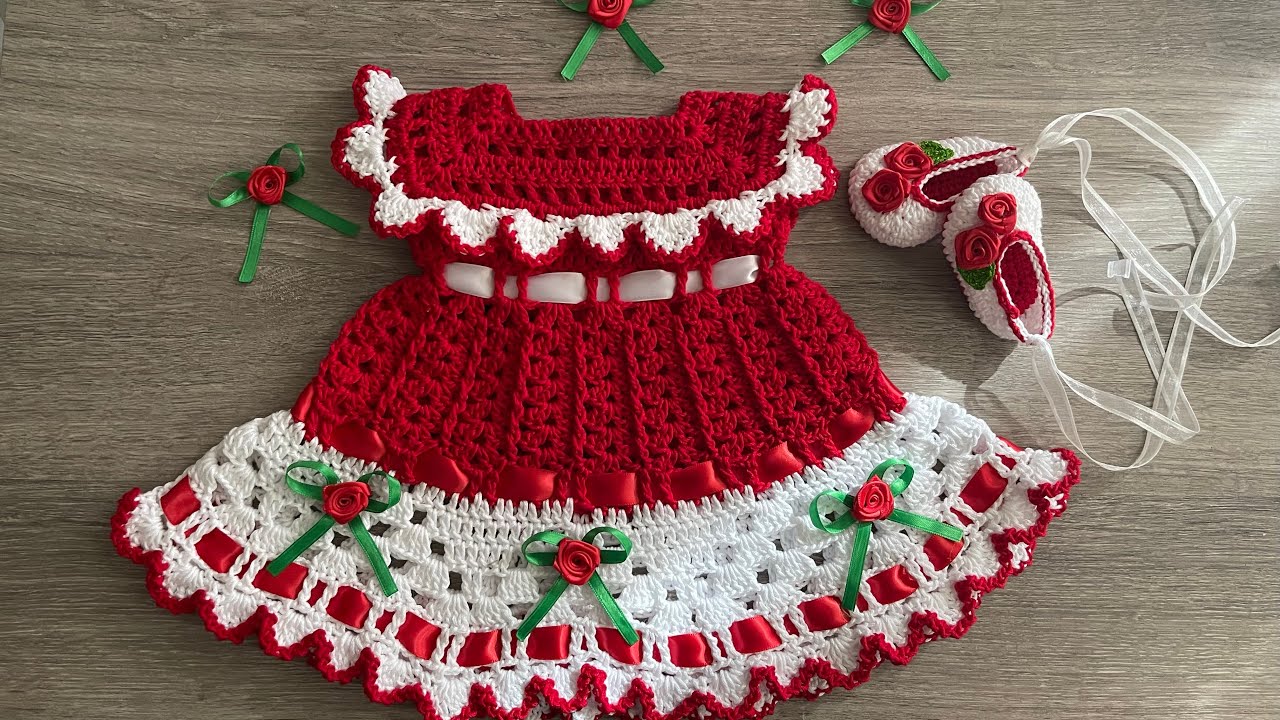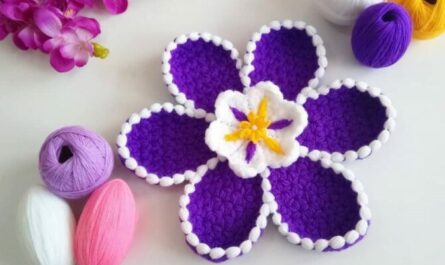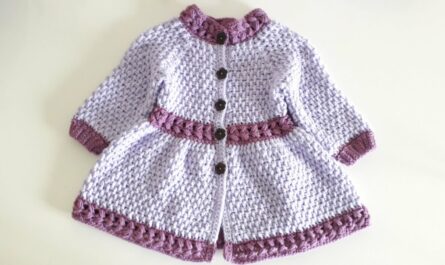There’s something truly enchanting about a baby dressed in festive attire, and a handmade Christmas crochet dress adds an extra layer of love and cheer to the holiday season. Imagine the smiles as a tiny little one twinkles in their special outfit, crafted stitch by delicate stitch by you!
This detailed tutorial will guide you through crocheting a beautiful Christmas baby dress, focusing on the versatile top-down, seamless raglan yoke construction. This method is perfect for babies due to its comfort (no bulky side seams!), adaptability for different sizes, and relatively straightforward progression. We’ll weave in festive touches throughout the design to make it truly sparkle!
What Makes it a “Christmas” Dress? Designing the Festive Feel
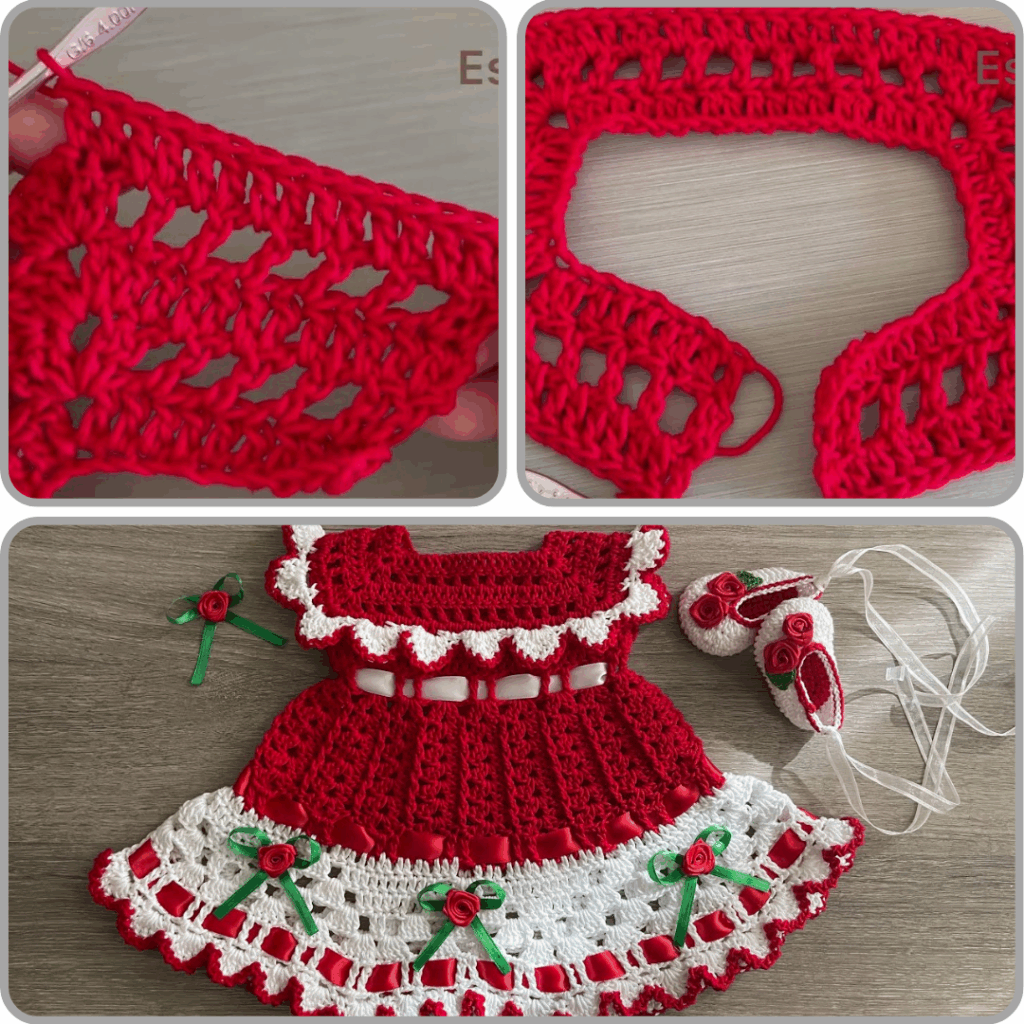
The magic of a Christmas dress lies in its visual cues. Here’s how to infuse holiday spirit into your design:
- Colors:
- Traditional: Vibrant reds (cranberry, true red), deep forest greens, crisp whites, and touches of gold or silver.
- Modern Pastels: Soft mints, blush pinks, creams, and muted golds.
- Stitch Patterns:
- Texture: Simple bobble stitches (used sparingly for babies) or puff stitches can evoke snow or ornaments.
- Subtle Lace: V-stitches or small shell patterns can add delicate elegance.
- Sparkle: Incorporating a strand of metallic yarn or using yarn with a subtle glitter fleck.
- Embellishments:
- Appliqués: Crocheted holly leaves and berries, tiny snowflakes, or candy canes.
- Bows: Small ribbon bows securely stitched on.
- Buttons: Festive red, green, white, or gold buttons.
Essential Preparations: Tools & Materials for Your Holiday Project
Gathering your supplies is the first step to creating this cherished garment.
- Yarn (Prioritize Softness & Washability!):
- Fiber:
- Baby-Specific Acrylic: Very soft, durable, hypoallergenic, and machine washable – perfect for baby clothes.
- Superwash Merino Wool: Luxuriously soft, warm yet breathable, and conveniently machine washable.
- Cotton or Cotton Blends: Breathable, absorbent, and great for any climate, offering crisp stitch definition.
- Weight: DK (Double Knitting) or Sport Weight are highly recommended. They create a lovely drape, work up at a reasonable pace, and are perfect for delicate baby garments.
- Colors:
- Main Color: Your primary festive color (e.g., vibrant red, deep green, or classic white/ivory).
- Accent Colors: Contrasting colors for details (e.g., white for a ‘snow’ border, green for holly, gold for sparkle).
- Quantity: For a typical baby dress (Newborn to 12 months), expect to need approximately 200-400 yards (approx. 180-365 meters) of yarn in total, depending on size and stitch pattern.
- Fiber:
- Crochet Hook:
- Your yarn label will suggest a hook size (e.g., 3.5mm-5.0mm).
- Crucial: The correct hook size for your gauge is more important than the label’s suggestion. You’ll likely need to adjust your hook to match your desired gauge.
- Other Notions:
- Stitch Markers: Absolutely essential for marking raglan lines and the beginning of rounds.
- Tapestry Needle: For neatly weaving in ends and sewing on embellishments.
- Scissors.
- Buttons: 3-5 small, flat buttons (approx. 0.5 inch / 1.25 cm). Choose festive colors (red, green, gold, white) or clear ones.
The Cornerstone of Success: Sizing & Gauge (Ensuring a Perfect Fit)
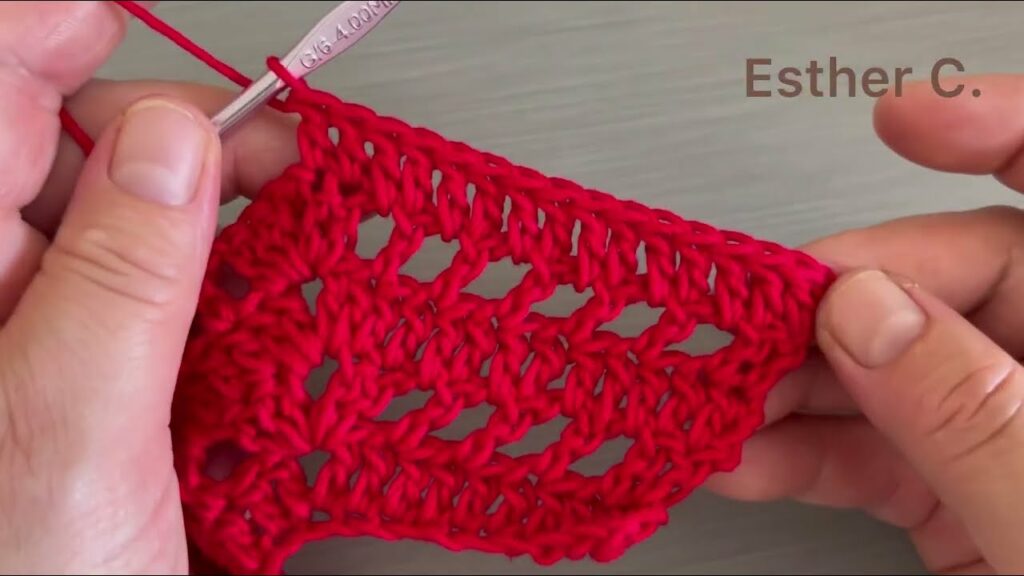
Getting the right fit is paramount for a baby dress, especially for a special occasion. For a comfortable fit, aim for about 1-2 inches (2.5-5 cm) of positive ease (meaning the dress is slightly larger than the baby’s actual measurement).
Typical Baby Sizes & Measurements (Finished Garment Chest Circumference & Yoke Depth):
| Size | Approx. Finished Chest Circ. | Approx. Yoke Depth (neckline to underarm) |
|---|---|---|
| Newborn | 16-18 inches (40-45 cm) | 4.5 inches (11.5 cm) |
| 0-3 Months | 17-19 inches (43-48 cm) | 5 inches (12.5 cm) |
| 3-6 Months | 18-20 inches (45-50 cm) | 5.5 inches (14 cm) |
| 6-12 Months | 19-21 inches (48-53 cm) | 6 inches (15 cm) |
Export to Sheets
Disclaimer: These are averages. Always refer to your specific pattern’s size chart and finished measurements.
How to Make a Gauge Swatch (Do NOT Skip This!):
- Chain: Chain about 20-25 stitches, plus the turning chains (e.g., ch 3 for dc) as per your chosen main stitch.
- Work: Crochet a square of at least 6×6 inches (15×15 cm) in the main stitch pattern you’ll be using for the dress (e.g., double crochet). A larger swatch gives a more accurate measurement.
- Wash & Block: Fasten off your swatch. Crucially, wash and block your swatch exactly as you plan to treat the finished dress. This relaxes the fibers and shows the true stitch size and drape.
- Measure: Once dry, lay the swatch flat. Place a ruler over the center. Count how many stitches fit within 4 inches (10 cm) and how many rows fit within 4 inches (10 cm).
- Adjust:
- If you have more stitches per inch than the pattern states (your work is too tight), go up half a hook size and try again.
- If you have fewer stitches per inch than the pattern states (your work is too loose), go down half a hook size and try again.
- Repeat until your gauge precisely matches the pattern’s recommendation.
General Stitch Patterns for Festive Flair:
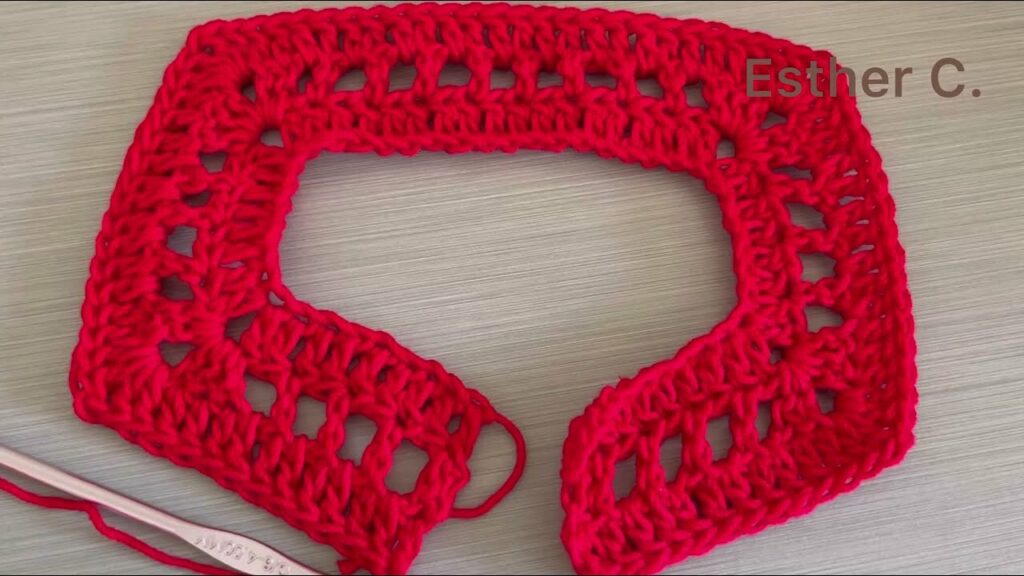
- Main Body:
- Double Crochet (dc): Fast, drapes beautifully.
- Half Double Crochet (hdc): Denser, warmer fabric.
- V-stitch: (dc, ch 1, dc in same st/sp) Creates simple lace, great for festive stripes.
- Edgings/Bands:
- Single Crochet (sc): Firm, neat edge.
- Picot Stitch: (ch 3, sl st into 1st ch) Creates a delicate, decorative scallop – perfect for a ‘snow’ or ‘bead’ look.
- Shell Stitch: Clusters of stitches (e.g., 5 dc in one st) create a festive, scalloped border.
- Festive Textures (Use Sparingly for Babies):
- Puff Stitch: (Yarn over, insert hook, pull up loop 3-4 times, pull through all loops) Creates little ‘bumps’ that can resemble tiny ornaments or berries. Use judiciously to avoid bulk.
Step-by-Step Construction: Crocheting Your Christmas Baby Dress
This guide outlines the common construction steps. For precise stitch counts and unique design details, always refer to a specific pattern for your chosen size.
Abbreviations Used:
- ch: chain
- sc: single crochet
- hdc: half double crochet
- dc: double crochet
- sl st: slip stitch
- st(s): stitch(es)
- sk: skip
- inc: increase (e.g., 2 dc in one st)
- […] : repeat instructions in brackets
- (…) : stitch count at end of row/round
- Color changes: Change color on the last yarn over of the previous stitch.
Phase 1: The Yoke (The Foundation of Festive Fit)
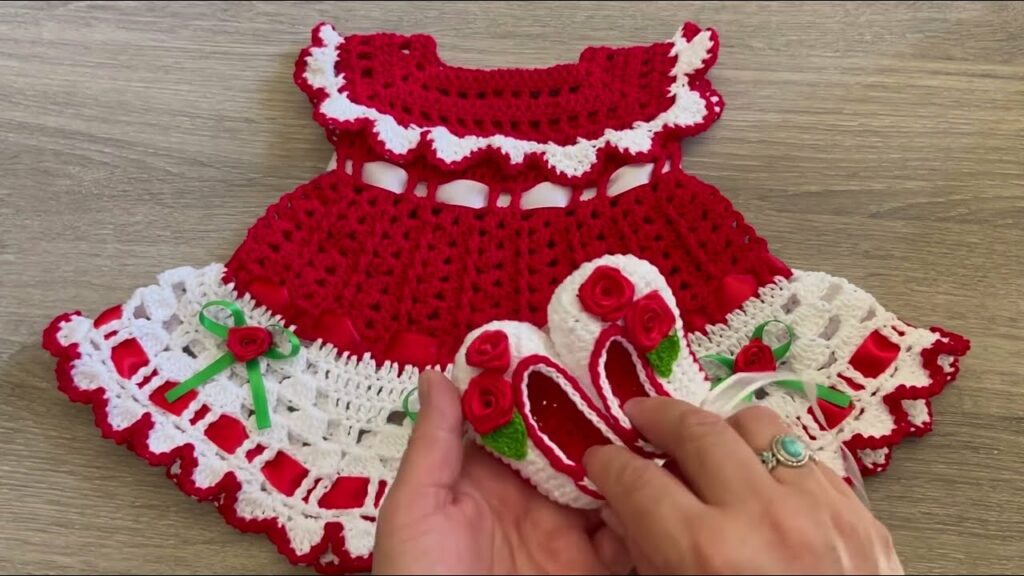
The yoke forms the upper part of the dress, worked flat for a back opening.
- Step 1.1: Starting the Neckline & Back Opening
- Foundation Chain: With your primary Christmas color (e.g., red or green), chain a length that slightly exceeds your desired neckline circumference, plus extra for the back opening placket.
- Neckband Rows: Ch 2 (counts as hdc or not, as per pattern). Work 1 hdc (or sc) in the 3rd ch from hook and in each ch across. Turn. Work 2-3 more rows to create a stable neckband.
- Buttonholes: On one of the back placket edges (usually the wearer’s right side for girls), create small buttonholes (e.g., 3-5 evenly spaced).
- To make a simple horizontal buttonhole: Work to desired position, ch 2, sk next 2 sts, then continue across. On the next row, work into the ch-2 space.
- Step 1.2: Establishing Raglan Yoke & Increases This forms the shoulder shaping.
- Divide Stitches: Take your total stitch count from the neckband. Your pattern will tell you how to divide these stitches into Back Panel 1, Sleeve 1, Front, Sleeve 2, and Back Panel 2. You will have 4 raglan corners where increases occur.
- First Yoke Row:
- Ch 3 (counts as first dc). Dc in sts for Back Panel 1.
- Raglan Corner 1: Work your increase (e.g., [2 dc, ch 2, 2 dc] or [dc, ch 1, dc]) in the next stitch. Place a stitch marker in the ch-2 space (or ch-1 space).
- Dc in sts for Sleeve 1.
- Raglan Corner 2: Work increase and place marker.
- Dc in sts for Front.
- Raglan Corner 3: Work increase and place marker.
- Dc in sts for Sleeve 2.
- Raglan Corner 4: Work increase and place marker.
- Dc in remaining sts for Back Panel 2. Turn.
- Continuing Yoke Rows: Ch 3. Dc in each dc across, working your specified increase into each raglan space. Move stitch markers up. Turn.
- Christmas Touch on Yoke: Consider working a few rows of white or a contrasting accent color into the yoke for stripes, or using a festive stitch around the raglan lines, during this stage.
- Yoke Depth: Repeat these increase rows until the yoke reaches the desired depth for your chosen baby size (refer to chart above). Continue adding buttonholes on the placket if needed.
Phase 2: Body & Sleeves (The Festive Dress Design)
Once the yoke is the correct depth, you’ll separate the body and sleeves.
- Step 2.1: Separating for Body and Sleeves
- Separation Row:
- Work stitches for Back Panel 1.
- Work 1 dc into Raglan Corner 1.
- Skip Sleeve 1: Skip all dc stitches of Sleeve 1.
- Underarm Chain: Ch 2-4 stitches (to form the underarm space; check pattern).
- Work 1 dc into Raglan Corner 2.
- Work dc in stitches for the Front Panel.
- Work 1 dc into Raglan Corner 3.
- Skip Sleeve 2: Skip all dc stitches of Sleeve 2.
- Underarm Chain: Ch 2-4 stitches.
- Work 1 dc into Raglan Corner 4.
- Work dc in stitches for Back Panel 2. Turn.
- Sleeve Stitches: Place the skipped sleeve stitches onto a piece of scrap yarn or a stitch holder for later.
- Separation Row:
- Step 2.2: Crocheting the Body/Skirt
- First Body Row: Ch 3. Work dc in each dc across, including working 1 dc into each chain of the underarm chains. Turn.
- Continuing the Body & Christmas Flair: Continue working rows of dc (keeping the back opening flat).
- Color Blocking/Stripes: Alternate rows of your main color with accent colors (e.g., 2 rows red, 1 row white, 2 rows green).
- Texture: Introduce a festive stitch like a simple V-stitch pattern every few rows, or scatter a few small puff stitches if desired (ensure they are not too bulky for baby).
- Flare: To create an A-line or fuller skirt, incorporate gentle increases (e.g., on every 5th or 6th row, work 2 dc into an evenly spaced stitch 4-8 times across the row).
- Length: Continue working rows until the dress reaches the desired Christmas dress length (e.g., to the knee or mid-calf, typically 12-16 inches / 30-40 cm total length from shoulder).
- Hem: Finish with 2-3 rows of sc or hdc for a neat, stable hem. Consider an accent color here (e.g., a white ‘snow’ border). Fasten off.
- Step 2.3: Crocheting the Sleeves (Optional)
- Attach Yarn: With your dress right side out, attach yarn to one of the underarm corners of a skipped sleeve.
- Pick Up Stitches: Ch 3. Work dc into each dc stitch of the held sleeve stitches and 1 dc into each chain of the underarm chain. Join with a sl st to the top of the initial ch 3. (You are now working in the round.)
- Work Sleeve: Continue working dc rounds (or your desired sleeve stitch) until the sleeve reaches the desired length. Match the body’s color pattern if desired, or use a solid accent color.
- Cuff: Finish with 2-3 rounds of sc or hdc for a neat cuff, possibly in an accent color. Fasten off.
- Repeat: Repeat for the second sleeve.
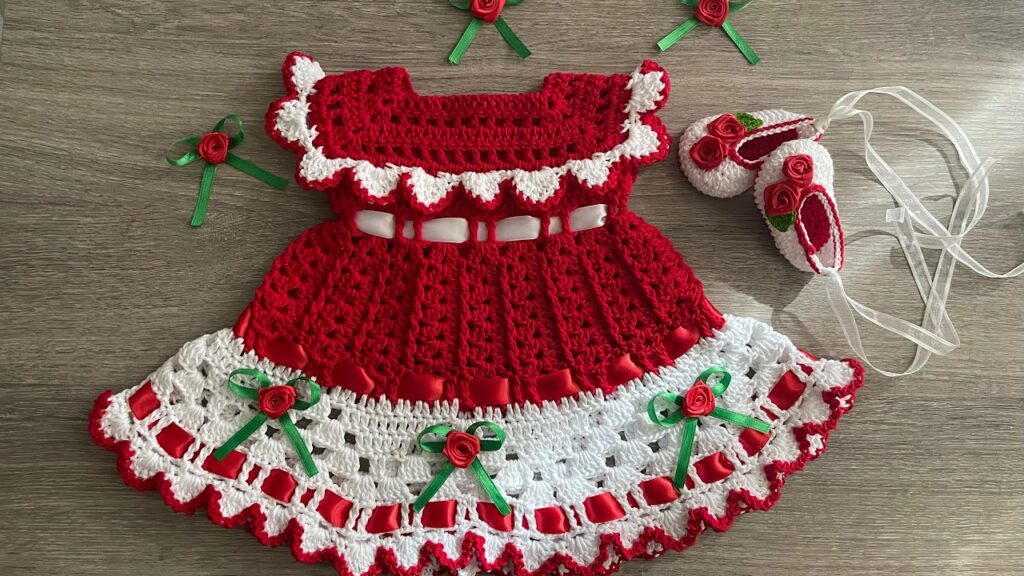
Phase 3: The Finishing Touches (Sparkle & Shine)
This is where your Christmas dress truly comes to life!
- Step 3.1: Edgings
- Neckline: Reattach yarn to one corner of the neckline. Work 1-2 rounds of sc or hdc around the entire neckline. Consider a simple border in an accent color (e.g., white with picot stitches or gold sc).
- Back Opening/Button Bands: If you didn’t integrate buttonholes directly into a flat band, now pick up stitches along both back opening edges. Work 2-3 rows of sc or hdc for each band; create buttonholes on one side.
- Hem & Cuffs: Add any final decorative edgings here if you didn’t do so in previous steps (e.g., a row of white shells or tiny red picots on a green background).
- Step 3.2: Weaving in Ends: This is paramount for a professional, beautiful look. Use your tapestry needle to meticulously weave in all loose yarn tails, hiding them securely within the stitches on the wrong side.
- Step 3.3: Blocking (Crucial!):
- Gently wash your finished dress according to your yarn’s care instructions.
- Gently squeeze out excess water (do not wring).
- Lay the dress flat on clean towels or blocking mats. Gently shape it to the correct dimensions for your chosen size, smoothing out any unevenness and opening up any stitch patterns. Use rust-proof pins to hold it in place.
- Allow the dress to air dry completely. Blocking truly transforms the fabric, enhancing drape and setting the shape.
- Step 3.4: Attaching Buttons: Lay your dress flat and mark the positions for your buttons, aligning them with the buttonholes. Securely sew on your chosen festive buttons. Ensure they are sewn on very, very tightly with strong thread to prevent any choking hazard for the baby.
- Step 3.5: Festive Embellishments (with EXTREME Safety Warnings!)
- Crocheted Appliqués: Stitch on small, flat crocheted holly leaves (green dc shapes) with embroidered red “berries” (French knots or small red yarn circles). A tiny embroidered snowflake or candy cane can also be charming. Ensure these are sewn on very securely.
- Ribbon Bows: Tie small festive ribbon bows and securely stitch them to the bodice or at the neck. Ensure no long ties or loops are left hanging that could pose a strangulation hazard.
- ABSOLUTELY NO LOOSE PARTS: Never use small beads, sequins, jingle bells, or any other tiny, detachable items on baby clothing. These are severe choking hazards.
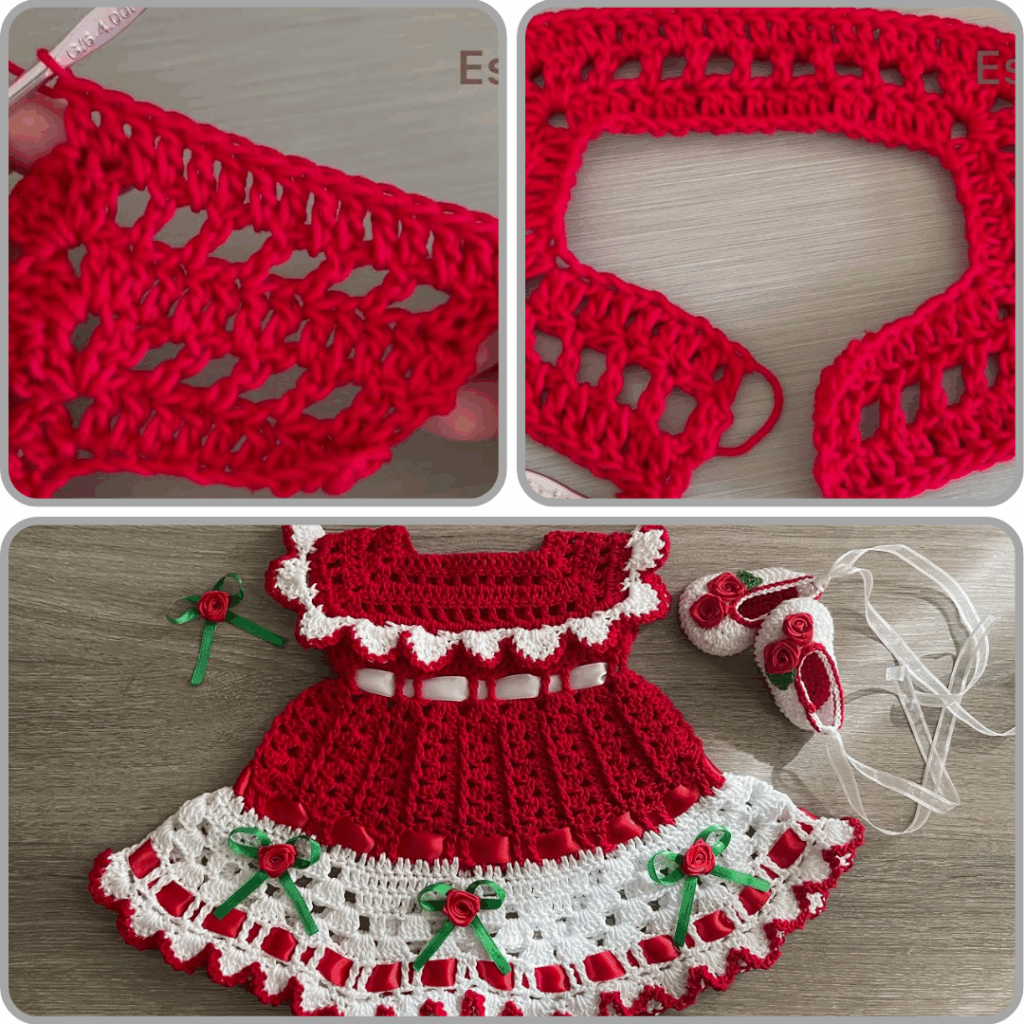
General Tips for Success & Safety
- Read Your Pattern Carefully: This guide provides the method. A specific pattern for your chosen size will give you the exact stitch counts and unique design details. Read it entirely before you start.
- Use Stitch Markers Generously: They are invaluable for marking raglan corners, the beginning of rounds, buttonhole placements, and any tricky sections.
- Count Your Stitches Regularly: Especially on increase rows/rounds. Counting prevents mistakes that are harder to fix later.
- Maintain Consistent Tension: This comes with practice, but striving for even tension ensures your fabric has a uniform look and the correct drape.
- Baby Safety First: Always prioritize safety in handmade baby items. Secure all elements.
Video Tutorial :
Creating a crocheted Christmas baby dress is a joyous undertaking, blending the warmth of a handmade gift with the festive spirit of the holidays. Your little one will look absolutely precious, and you’ll have created a cherished memory for years to come! Happy crocheting and Merry Christmas!
